Beijingwalker
Elite Member
- Nov 4, 2011
- 74,325
- 103,366
- Country of Origin

- Country of Residence

China Wants a Big Fleet of 5 Aircraft Carriers by 2030
China's naval expansion includes plans to significantly increase its aircraft carrier capabilities, aiming to grow its fleet to potentially five carriers by 2030 despite operating only two.by Maya Carlin
March 1, 2024

Summary: China's naval expansion includes plans to significantly increase its aircraft carrier capabilities, aiming to grow its fleet to potentially five carriers by 2030 despite operating only two. This move is part of China's broader strategy to enhance its naval power and extend its reach within the Indo-Pacific region, particularly in contrast to the U.S. Navy's superior capability and power projection. China's carrier development journey began with the acquisition of retired carriers, evolving to the domestically-built Shandong and the advanced Fujian, the latter employing electromagnetic catapults. This expansion reflects China's ambition to match or exceed global naval powers, underscoring the strategic importance of aircraft carriers in modern geopolitical dynamics.
China's Naval Ambitions: A Path to Five Aircraft Carriers by 2030
As tensions between Washington and Beijing continue to escalate, the potentiality for a future kinetic conflict is growing. China has been rapidly expanding its naval prowess over the last decade and officially possesses a fleet larger than America’s. According to the Pentagon’s 2023 China Military Power Report, the People’s Liberation Army’s Navy (PLAN) is expected to grow to 395 ships by 2025.Comparably, the U.S. Navy is expected to reach 300 vessels by the early 2030s. While Beijing’s larger fleet may be concerning, the U.S. Navy is arguably far more powerful in terms of capability and power projection. One area where PLAN is lacking is the aircraft carrier space. China has two carriers in service today, while the U.S. possesses 11. These numbers may change since Beijing is prioritizing the development of additional carriers.
According to the U.S. Naval Institute, the PLAN has the resources to construct up to five carriers and 10 nuclear ballistic missile submarines by 2030.
China’s Aircraft Carrier History
Since the Cold War, China has acquired four retired aircraft carriers: the Soviet-era Minsk, Kiev, and Varyag and the British-built Australian HMAS Melbourne. Ultimately, Varyag would be reclassified as Liaoning and became China’s first aircraft carrier. The Kuznetsov-class ship was developed by the USSR during its push to expand its naval fleet. The ship was laid down in Mykolaiv, Ukrainian SSR, in 1985 as Riga and was later redesignated as Varyag. When the Soviet Union collapsed in 1991, Varyag was not fully completed and construction was halted. Ukraine opted to sell the carrier and was approached by China, India and Russia as potential client states. Ultimately, China purchased the aircraft carrier for $20 million, which was a huge bargain at the time.Once Varyag reached Chinese waters, an overhaul to modernize the carrier commenced. Engineers installed the Type 348 active electronically scanned array (AESA) radar and Sea Eagle radar on the carrier, in addition to other enhancements. By 2011, the newly named Liaoning commenced her sea trials with Shenyang J-15 aircraft and YJ-83K, KJ-88, and YJ-91 missiles. In 2014, the carrier was outfitted to carry 24 J-15 fighters, six Changhe Z-18F anti-submarine warfare helicopters, two Harbin Z-9C rescue helicopters and four Z-18J airborne early warning helicopters.
Introducing Shandong
China’s second carrier is the first to be constructed domestically. Shandong was designed for service in PLAN and is derived heavily from Liaoning. Designated as a Type 002 ship, Shandong received the North Atlantic Treaty Organization (NATO) name Kuznetsov Mod when first commissioned since the carrier is essentially a modified version of the Kuznetsov-class Varyag. While both carriers are similar, Shandong was designed to prioritize aircraft operations better. The Dalian Shipbuilding in Liaoning manufactured the carrier beginning in 2013. By 2015, the ship’s keel was laid down. Since its official introduction to service in 2018, Shandong has participated in various exercises, including the April 2023 United Sharp Sword military drills in the Philippine Sea.Introducing Fujian
China’s Type 003 aircraft carrier is named Fujian. The carrier was constructed by the Jiangnan Shipyard for the PLAN and was officially launched in 2022. While the Liaoning and Shandong launch aircraft with ski jumps, the Fujian reportedly uses steam turbines and electromagnetic catapults. Some analysts have compared depictions of the new carrier to the American-made Kitty Hawk-class ships. Fujian is expected to undergo its sea trials in 2024. While this carrier is more advanced than its predecessors, it may not be a true near-peer to its American-made counterparts.As detailed by Radio Free Asia, “As a ship, Fujian is only about 80% as large as existing U.S. carriers, and is conventionally propelled rather than nuclear, which makes a big difference for range, endurance, and carrying capacity. For the first ship of a new class, the entire process of trials can often take a year or more. Her predecessor, Shandong, took 19 months from completion to commissioning and was of a far less advanced design.”
When the Fujian is introduced to service, it will join the U.S. Gerald R. Ford-class aircraft carriers as the only ships in the world equipped with the latest Electro-magnetic Aircraft Launch System (EMALS). Reports indicate that China’s version of EMALS will allow it to launch more aircraft from its new carrier. This capability, paired with Beijing’s hostile behavior in the South China Sea directed at Taiwan, is concerning.
As China continues to expand its aircraft carrier arsenal further over the next few years, its naval prowess and power projection will grow with its fleet.




